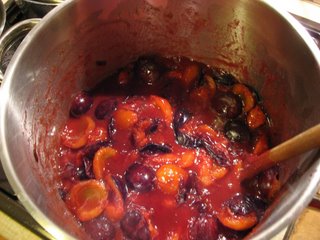little barries
one of my favourite fruits at the moment are elderberries. they taste good, they are easy to spot during walks in parks or wienerwald, can be stolen from branches hanging over fences (an old family tradition) or bought at farmer markets.
i made elderberry compote which goes very well with grießbrei (semolina cooked in milk, vaguely resembling warm custard).
grießbrei mit hollerkompott
- 2 cups of milk
- 3 tablespoons of semolina
- 2 tablespoons of sugar
- one tablespoon of butter
- vanilla and/or lemon zest to taste
- eight to ten panicles of elderberries
- five plums or an apple or a pear
- honey to taste
- cinnamon to taste, a pinch of ground cloves
bring milk to the boil, wisk in semolina and cook until soft (about five minutes). stir in sugar, butter and vanilla extract/lemon zest.
strip elderberries from panicles into a saucepan with a fork. add halved plums or diced apple/pear, spices and a little water to prevent burning. bring to the boil and simmer until fruit is very soft and mushy. adjust sweetness with honey to taste (about two tablespoons).
serve together in bowls

grießbrei is often considered babyfood but it has a long tradition as comfort food in my family. i like it sprinkled with cinnamon or chocolate shavings and with chunks of banana stirred in. you can prepare a sort of pudding by cooking grießbrei until it is very stiff, cooling slightly, mixing in three or four eggs (separated) and baking it for fourty minutes on medium heat.
i also made a batch of elderberry jam but i won't post a recipe because i just followed the basic rules for canning: equal amounts of sugar and fruit (added a couple of plums and a pear here as well), cinnamon, cloves, sterilized jars - you know the drill.
next time i will use a little less sugar though, because the one to one ratio produced a very sweet jam (well to my taste at least, other people don't seem to mind that).




